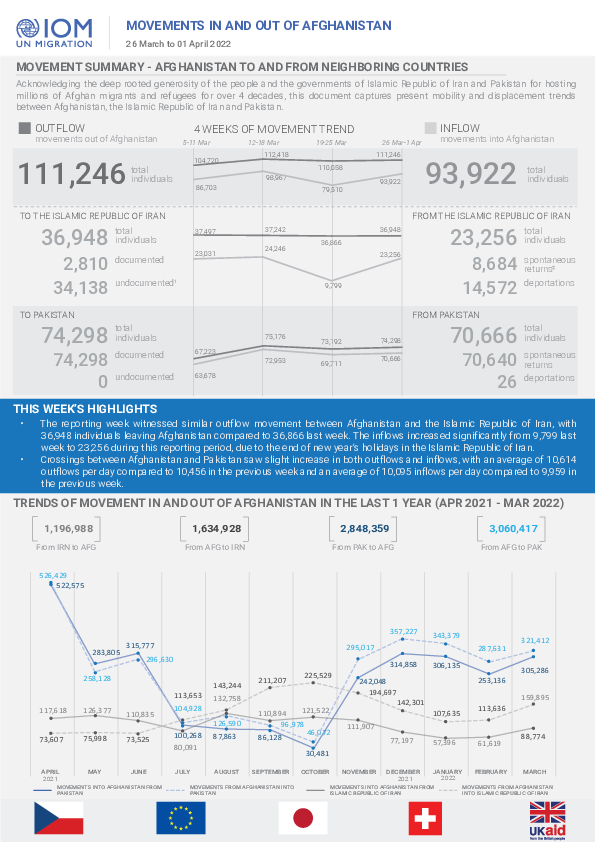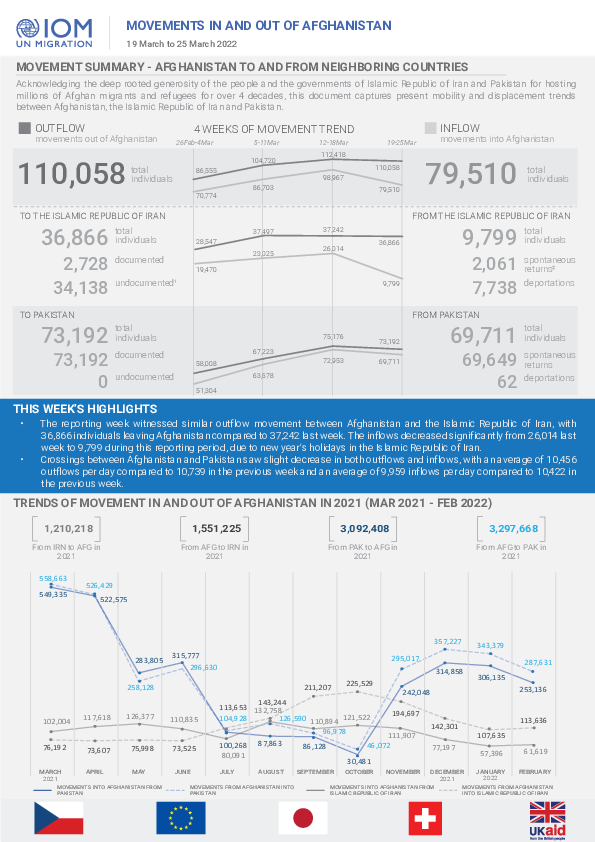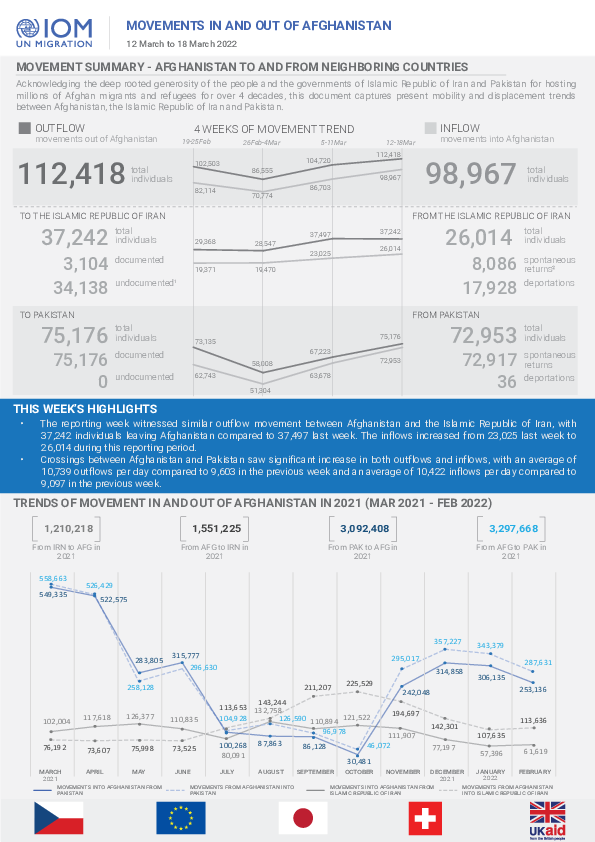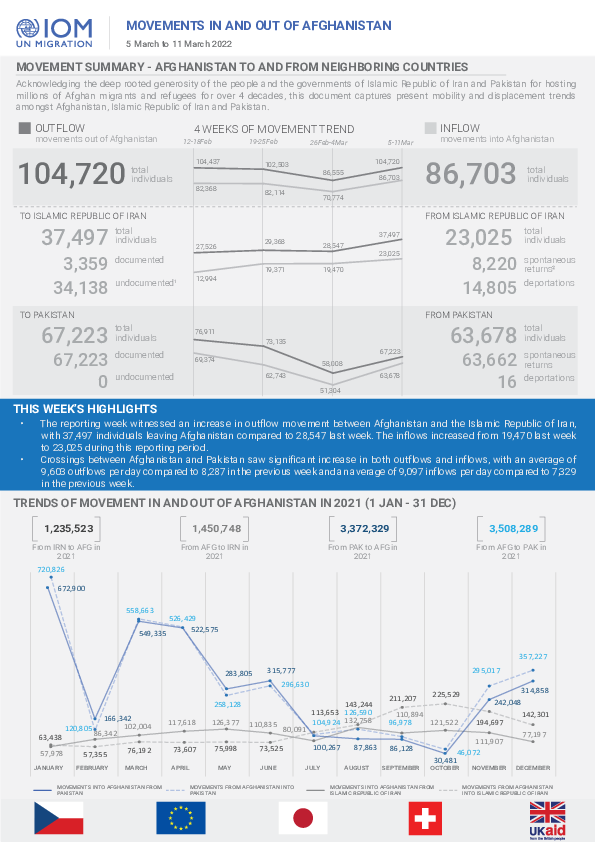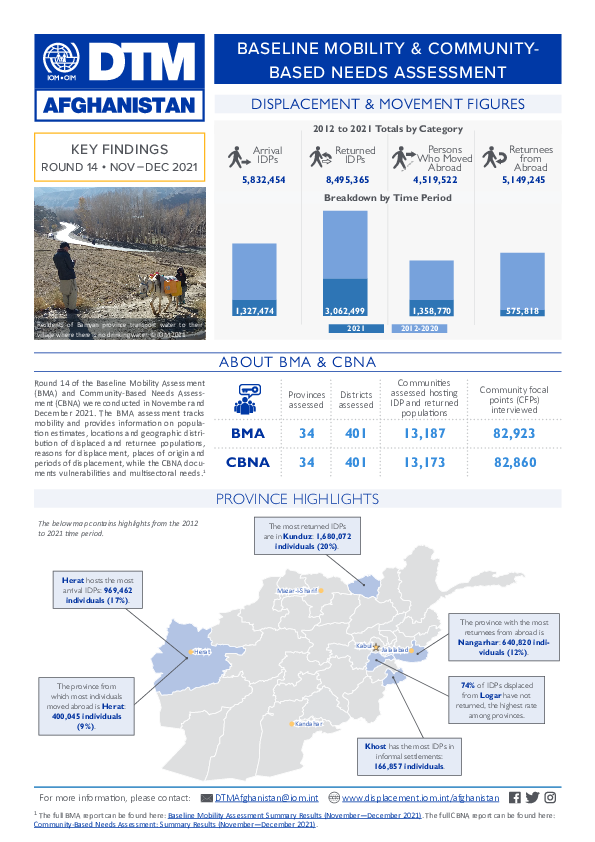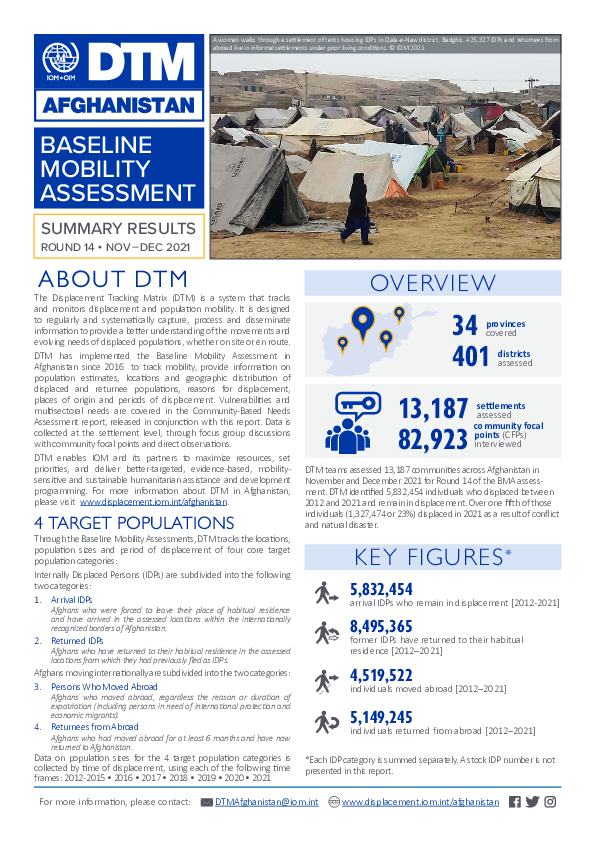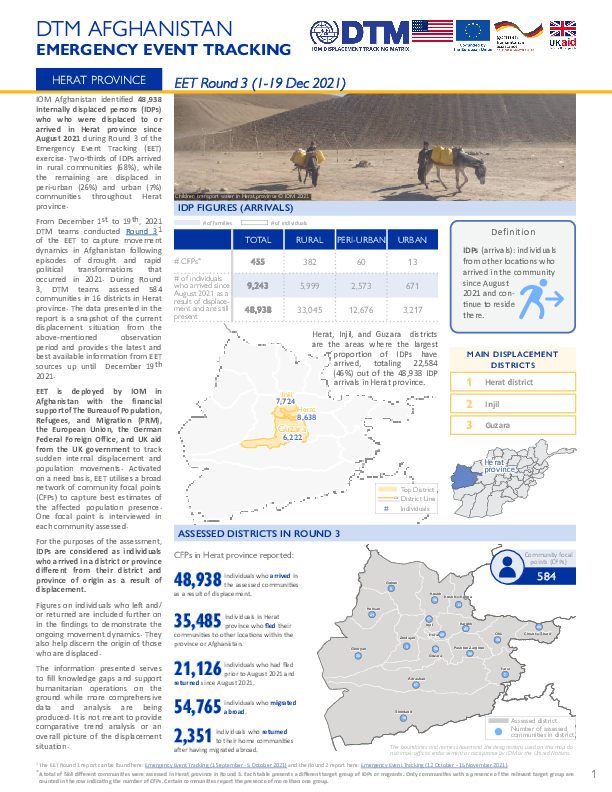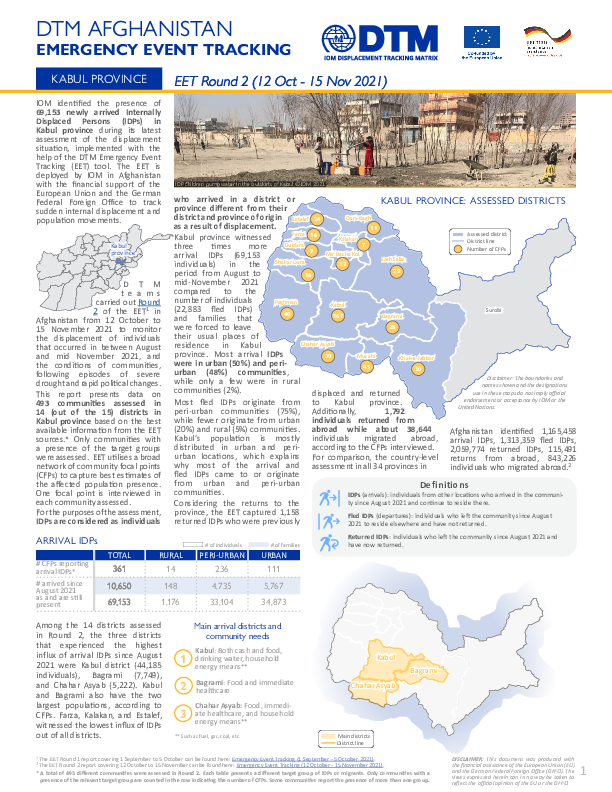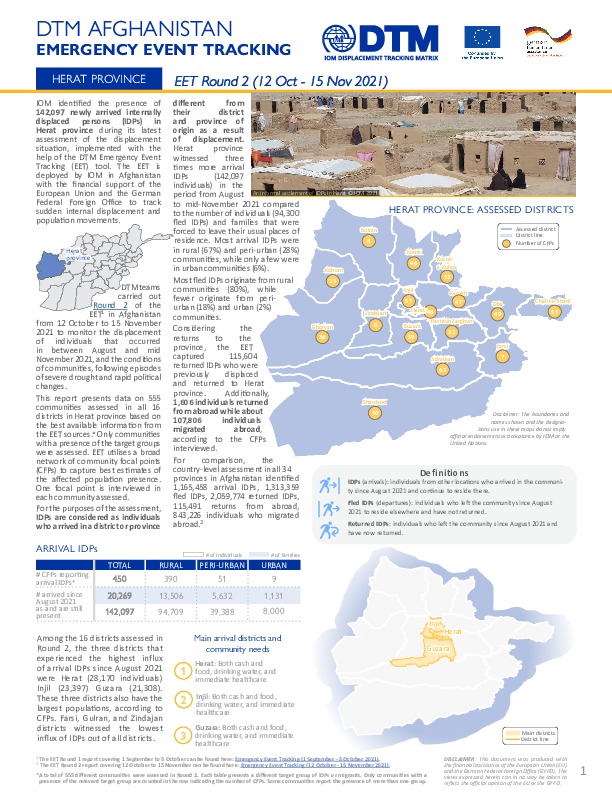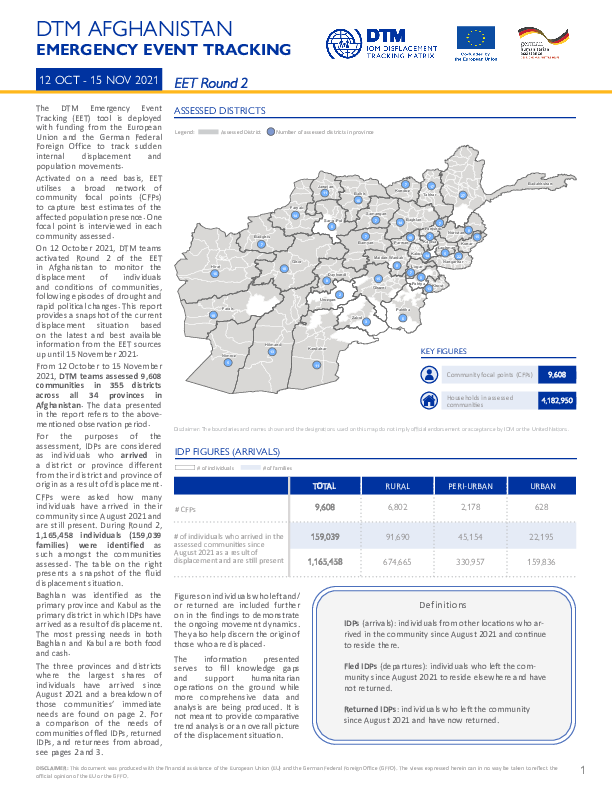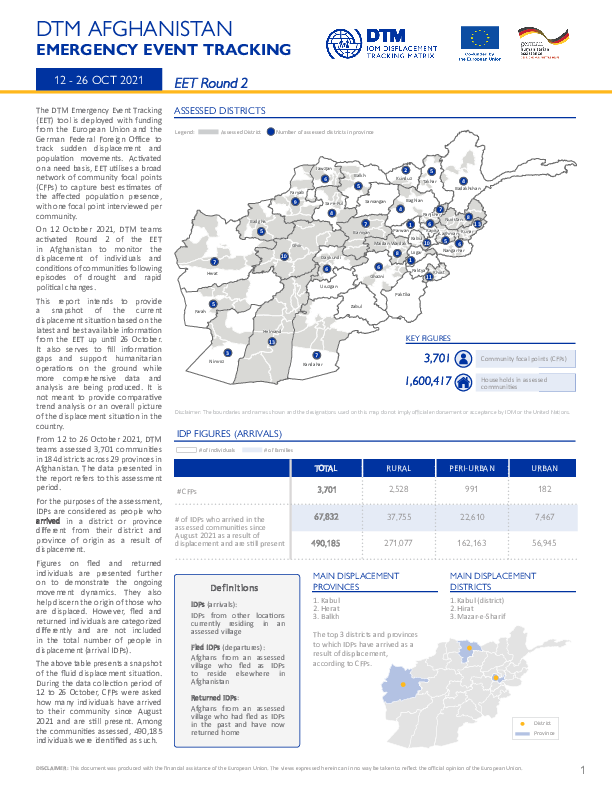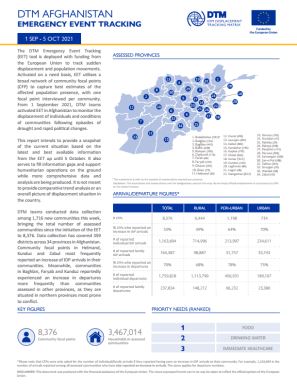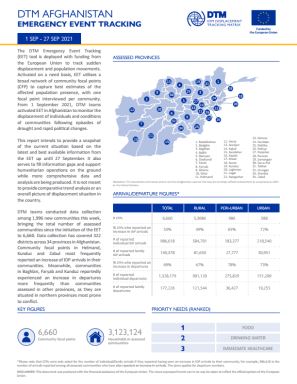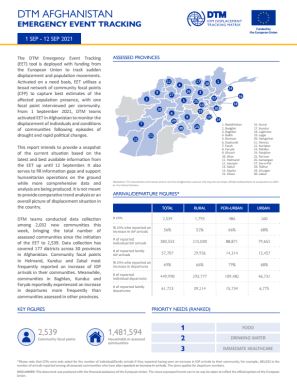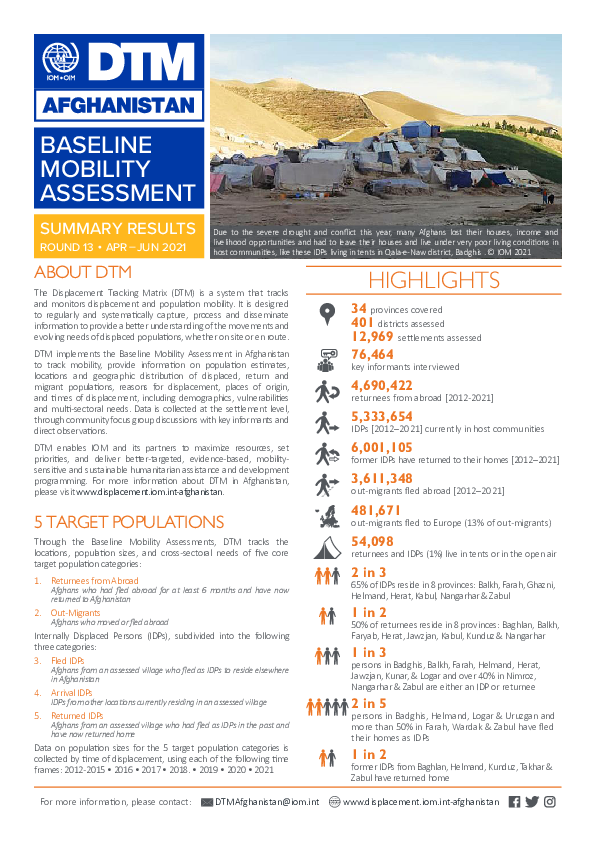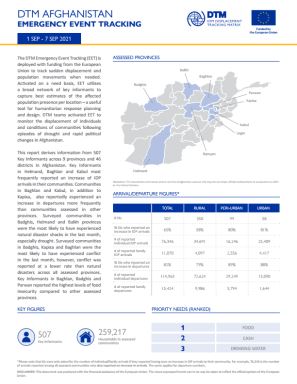-
Countries
-
Data and Analysis
-
Special Focus
-
Crisis Responses
Afghanistan
Afghanistan
Desplazados internos rastreados
Movimientos de desplazamiento
4,187,000
IDMC 2023
Ronda de recopilación de datos
Sobre Afghanistan
The Displacement Tracking Matrix (DTM) is an information management system of tools and methodologies used to track and monitor displacement and population mobility. In Afghanistan, IOM activated the DTM programme in January 2017 in response to the substantial increase of Afghans returning home from neighbouring countries, as well as record levels of internal displacement. DTM in Afghanistan is designed to regularly and systematically capture, process and disseminate multi-layered information about the population sizes, locations, geographic distribution, movements, vulnerabilities, evolving multisectoral needs, and the drivers of migration of returnees, IDPs, migrants and mobile populations. DTM implements baseline mobility assessments, flow monitoring, registrations, and various migration surveys to provide an essential evidence base that enables decision-makers and humanitarian, reintegration and development partners to maximize resources and deliver efficient, better-targeted, mobility-sensitive and sustainable humanitarian; reintegration, community stabilization and development programming.
The value-added impact of DTM in Afghanistan is to inform action and results for people in need. DTM Afghanistan implements its activities at both the national and provincial levels. DTM works closely with other (IOM) programmes through referring identified populations in need of assistance at flow monitoring points to IOM’s Cross Border Return and Reintegration, Protection, Humanitarian Assistance, and Reintegration and Development (RADA) programmes. DTM Afghanistan also supports humanitarian partners and clusters, including WFP, FAO, UNHCR, IRC, DRC, NRC, and WHO, among many others, by providing emergency tracking updates in large-scale or sudden onset movements, such as emergency event tracking and drought response. Furthermore, stabilization and development actors, including IOM’s RADA programme, and the World Bank leverage DTM’s information to select priority communities and districts with higher concentrations of IDPs and returnees to receive reintegration and livelihoods assistance and improvements to core infrastructure and essential services. In support of health partners, including WHO, UNICEF, and the Humanitarian Health Cluster, DTM data informs the selection of priority, at-risk districts, border areas, communities, and health facilities in need of strengthened capacity, response, surveillance, and risk education for polio, TB, COVID-19, and other infectious diseases.
Contacto
Modher ALHAMADANI
Senior Programme Coordinator - DTM
malhamadani@iom.int
DTM AFGHANISTAN
DTMAFGHANISTAN@iom.int
Current Donors
- Republic of Korea
- Norway
- CERF
- Canada
- Italy
- EU
- FCDO
Para obtener resultados de búsqueda más avanzados, vaya a la Página de búsqueda avanzada de informes
Afghanistan — Emergency Event Tracking — Summary Brief: Coping Mechanisms in Response to Food Shortages (Rounds 1 and 2)
The Displacement Tracking Matrix (DTM) Emergency Event Tracking (EET) is deployed by IOM in Afghanistan with the financial support of the European Union and the German Federal Foreign Office to track sudden internal displacement and population movements.
Movement in and out of Afghanistan Snapshot (02- 08 Apr 2022)
The snapshot captures present mobility and displacement trends between Afghanistan, the Islamic Republic of Iran and Pakistan.
Movement in and out of Afghanistan Snapshot (26 Mar- 01 Apr 2022)
The snapshot captures present mobility and displacement trends between Afghanistan, the Islamic Republic of Iran and Pakistan.
Movement in and Out of Afghanistan Snapshot (19- 25 Mar 2022)
The snapshot captures present mobility and displacement trends between Afghanistan, the Islamic Republic of Iran and Pakistan.
Movement in and Out of Afghanistan Snapshot (12- 18 Mar 2022)
The snapshot captures present mobility and displacement trends between Afghanistan, the Islamic Republic of Iran and Pakistan.
Movement in and Out of Afghanistan Snapshot (05 - 11 Mar 2022)
The snapshot captures present mobility and displacement trends between Afghanistan, the Islamic Republic of Iran and Pakistan.
Afghanistan - Baseline Mobility and Community Based Needs Assessment (November-December 2021)
Round 14 of the Baseline Mobility Assessment (BMA) and Community-Based Needs Assessment (CBNA) were conducted in November and December 2021.
CBNA R14 — Afghanistan — Community-Based Needs Assessment: Summary Results (November—December 2021)
In November through December 2021, DTM implemented the Community-Based Needs Assessment (CBNA) at the settlement level, as an integral component of DTM's Baseline Mobility Assessment (BMA), providing a comprehensive overview of the evolving, multi-sectoral needs in settlements hosting IDPs and re
Afghanistan — Baseline Mobility Assessment Summary Results (November—December 2021)
In Afghanistan, DTM employs the Baseline Mobility Assessment tool, designed to track mobility, determine the population sizes, locations and geographic distribution of forcibly displaced, return and migrant populations, reasons for displacement, places of origin, and times of
Afghanistan — Emergency Event Tracking Kabul Province (1 December - 19 December 2021)
IOM Afghanistan identified 93,631 internally displaced persons (IDPs) who were displaced to or arrived in Kabul province since August 2021 during Round 3 of the Emergency
Afghanistan — Emergency Event Tracking Herat Province (01 December - 19 December 2021)
IOM Afghanistan identified 48,938 internally displaced persons (IDPs) who were displaced to or arrived in Herat province since August 2021 during Round 3 of the Emergency
Afghanistan — Emergency Event Tracking Round 3 (1 - 19 December 2021)
IOM Afghanistan identified 988,817 internally displaced persons (IDPs) who arrived in the assessed communities since
Afghanistan — Emergency Event Tracking Kabul Province (12 October - 15 November 2021)
IOM identified the presence of 69,153 newly arrived Internally Displaced Persons (IDPs) in Kabul province during its latest assessment of the displacement situation, implemented with the help of the DTM Emergency Event Tracking (EET) tool.
Afghanistan — Emergency Event Tracking Herat Province (12 October - 15 November 2021)
IOM identified the presence of 142,097 newly arrived internally displaced persons (IDPs) in Herat province during its latest assessment of the displacement situation, implemented with the help of the DTM Emergency Event Tracking (EET) tool.
Afghanistan — Emergency Event Tracking (12 October - 15 November 2021)
The DTM Emergency Event Tracking (EET) tool is deployed with funding from the European Union and the German Federal Foreign Office to track sudden internal displacement and population movements.
Afghanistan — Emergency Event Tracking (12 - 26 October 2021)
The DTM Emergency Event Tracking (EET) tool is deployed with funding from the European Union and the German Federal Foreign Office to track sudden displacement and population movements.
Afghanistan - RLS - Snapshot Report Round 2 ( 23 September - 16 October 2021)
This report intends to provide a snapshot of the second round of RLS data collection that took place between 23 September and 16 October with Afghan migrants who returned from Turkey or the EU between January 2018 and July 2021.
Afghanistan — Emergency Event Tracking (1 September - 5 October 2021)
The DTM Emergency Event Tracking (EET) is deployed with funding from the European Union to track sudden displacement and population movements when needed.
Afghanistan — Emergency Event Tracking (1 - 27 September 2021)
The DTM Emergency Event Tracking (EET) is deployed with funding from the European Union to track sudden displacement and population movements when needed.
Afghanistan — Emergency Event Tracking (1 - 20 September 2021)
The DTM Emergency Event Tracking (EET) tool is deployed with funding from the European Union to track sudden displacement and population movements.
Afghanistan — Emergency Event Tracking (1 - 12 September 2021)
The DTM Emergency Event Tracking (EET) tool is deployed with funding from the European Union to track sudden displacement and population movements.
CBNA R13 — Afghanistan — Community-Based Needs Assessment: Summary Results (April—June 2021)
In April through June 2021, DTM implemented the Community-Based Needs Assessment (CBNA) at the settlement level, as an integral component of DTM's Baseline Mobility Assessment (BMA), providing a comprehensive overview of the evolving, multi-sectoral needs in settlements hosting IDPs and returnees
Afghanistan — Baseline Mobility Assessment Summary Results (April—June 2021)
In Afghanistan, DTM employs the Baseline Mobility Assessment tool, designed to track mobility, determine the population sizes, locations and geographic distribution of forcibly displaced, return and migrant populations, reasons for displacement, places of origin, and times of
Afghanistan — Emergency Event Tracking (1 - 7 September 2021)
The DTM Emergency Event Tracking (EET) is deployed with funding from the European Union to track sudden displacement and population movements when needed.
Pagination
Para obtener resultados de búsqueda más avanzados, vaya a la Página de búsqueda avanzada de conjuntos de datos
Pagination
Pagination
- First page
- Previous page
- 1
- 2
- 3
- 4
- 5




